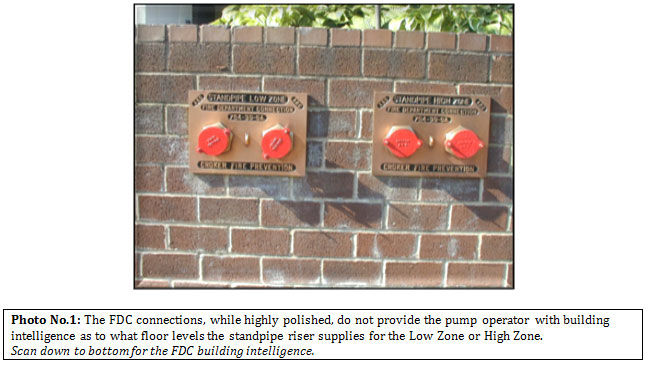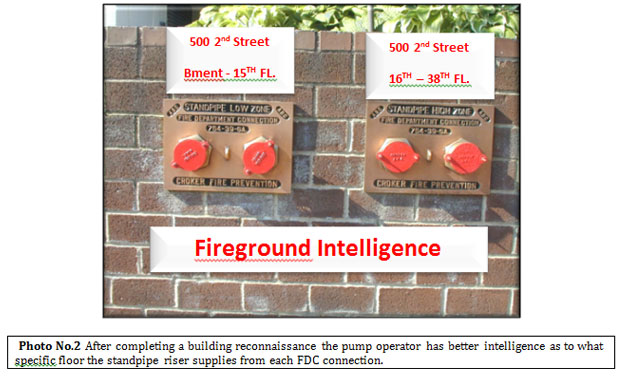Taming the Fire Environment: Building Intelligence for First-Due Fire Companies and Beyond, Part 2
By Jack Murphy and Sean DeCrane
With new essential building intelligence tools such as mobile portal applications, 21st Century firefighters can easily embrace a military mentality in analyzing our battlefield, the building. While exterior building observations will reveal the address, height, length and width, fire department connections, exposures to the building, etc. An interior reconnaissance will provide much needed information as to how the unique building features will react during a fire emergency and other non-fire related incidents. First-due fire companies that conduct building intelligence surveys will know ahead of time: construction classification, fire protection systems, type of occupancy, distinctive building systems, which stairwell access the roof and basement, floor layouts to assist with search and rescue efforts, hazardous materials, and potential building threats for firefighters, etc.
Lacking Building Intelligence

Scan down to bottom for the FDC building intelligence.
Using today’s technology, the on-the-ground military squad units can take advantage analyzing the battlefield before confronting the enemy such as:
- Terrain
- Weather conditions
- Battlefield threats and friendly capabilities
- Other friendly characteristics, etc.
Fire suppression units need to apply more a military-style intelligence gathering approach for our enemy, the building.
Analyze the building:
- Exterior exposures
- Interior floor layouts
- Structural elements
- Safety and precautions for a firefighters emergency response
- Our work environment: Potential threats and building system capabilities, etc.
|
It’s Time to Know Thy Enemy The military uses a host of intelligence sources to observe, gather, and analysis the enemy or threat, then preplans scenarios prior to sending forces into harm’s way. As a famous military tactician stated thousands of years ago: “If you know the enemy and know yourself, you need not fear the result of a hundred battles. If you know yourself but not the enemy, for every victory gained you will also suffer a defeat. If you know neither the enemy nor yourself, you will succumb in every battle.” Sun Tzu, The Art of War By James Dove, Major, U.S.M.C. |
An electronic building information card for first-due fire companies and command is an important component for the fire service to gather building intelligence as it relates to the fireground. Firefighters must continuously strive to understand the performance of our work environment. Understanding how a building is designed and constructed and the designed protection systems available to us will allow us to make informed decisions in these structures, which is our battlefield.
Sample with: Building Intelligence

References
electronic Building Information Card / eBIC: www.ebicard.com
Coffee Breaking Training–Transforming Your Department’s Response with Electronic Pre-Incident Planning, No. FM–2012-1 April 2, 2012. www.usfa.fema.gov/nfa/coffee-break/.
ICC– International Building Code (IBC/2012 Edition), Section 911.1.5 Building Information Card
ICC– International Fire Code (IFC/2012 Edition), Section 508.1.5 Building Information Card
National Fire Protection Association (NFPA) Standard 1620, Standard for Pre-Incident Planning (2010 Edition).
http://www.nfpa.org/searchResults?keywords=1620+standard&pageIndex=1
NFPA High-Rise Building Safety Advisory Committee: Guidelines to Developing Emergency Actions Plans for All-Hazard Emergencies in High-Rise Office Buildings: Section 2.3.1.6 Pre-Incident/Building Information Card
Insurance Standard Organization (ISO/2013 Edition), Section 580 Training: H. Building
Familiarization for Pre-Incident Planning: http://www.isomitigation.com/ppc/2000/ppc2001.html
NIST/WTC Committee 30 Recommendations: http://www.nist.gov/el/disasterstudies/wtc/
At the 2014 FDIC Conference watch for the classroom sessions on:
- Leveraging Building Intelligence for an Initial Response & Beyond [Instr. Jack J. Murphy]
- Firefighter Safety and Codes: A Necessary Partnership [Instr. Sean DeCrane]
Be safe out there.
Please send feedback to Lfdfmret@nj.rr.com.

Jack J. Murphy, MA, (left) is a Fire Marshal (ret.)/Fmr. Deputy Chief and currently serves as a Deputy Fire Coordinator for the N.J. Div. of Fire Safety for the Bergen Region. He is the Chairman of the New York City High-Rise Fire Safety Directors Assoc., a member of the NFPA High-Rise Building Safety Advisory and 1620-Pre-Incident Planning Committees. He has published various fire service articles and authored: RICS; Rapid Incident Command System Field Handbooks; the “Pre-Incident Planning” Chapter-29 of the Fire Engineering’s Handbook for Firefighter I & II; and co-authored, “Bridging the Gap: Fire Safety and Green Buildings.” He is a Fire Engineering contributing editor, an FDIC executive advisory board member, co-hosts Taming the Fire Environment on the Fire Engineering website and he has received the 2012 Fire Engineering Tom Brennan Lifetime Achievement Award.
Sean P. DeCrane, (right) is a 23+ year veteran of the Cleveland Fire Department. He currently serves as a Battalion Chief and Chief of Training for the Cleveland Fire Training Academy. Sean is a State of Ohio Certified Instructor and represents the International Association of Fire Fighters in the International Code Council. He also has served on the 2009 and 2012 International Fire Code Development Committees and is the current Committee Chair for the 2015 Edition. He was awarded the 2010 ICC Fire Service Award and the 2013 IAFC Fire Life Safety Section’s Fire Service Award. DeCrane also serves on the NFPA 1 Fire Code Technical Committee. In addition, Sean serves on the Underwriters Laboratories Fire Council, the United States Fire Administration’s Residential Fire Environment Workshop Project, the United States Fire Administration’s project on Fire Fighting Tactics in Wood-Frame Residential Construction and the Modern Fire Environment Education Committee. He is a contributor for Fire Engineering Magazine and co-hosts Taming the Fire Environment on the Fire Engineering Web site.

